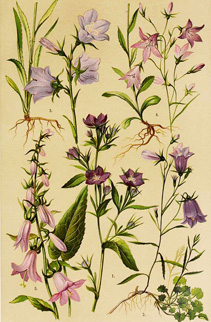Bewitching Bellflowers
By Audrey Stallsmith

Grant us fairy-tale magic, then, and three wishes all:
Wits to beware rampion from the witch’s garden
And the villain’s tainted fruit. . .
“Quest” by Audrey Stallsmith
One of the Grimms’ fairy tales proves what trouble can be caused by the strange appetites of pregnant women. In that story, a soon-to-be mother craves the rampion (Campanula rapunculus) growing in a neighboring witch’s garden and sends her husband to steal it.
In the end, he has to give the witch the baby in payment, and she is named Rapunzel after the plant. As my poem implies, that should teach us a lesson about not coveting the crops of the wicked!
Only one of the over 200 species of bell flowers in existence, rampion is grown to be eaten more than for its ornamental value. Its roots are boiled like parsnips, its shoots blanched like asparagus, and its leaves bolted like spinach.
Considering the story attributed to the plant, you won’t be surprised to hear that it has a reputation for inciting quarrels, but it could help soothe the sore throats caused by all that shouting as well. According to John Gerard's 1597 Herball, "Some affirme that the decoction of the roots are good for all inflammation of the mouth and almonds of the throte and other diseases happening in the mouth and throte, as the other Throte warts."
Unlike that one, most other bellflowers inhabit the flower rather than the vegetable garden. Campanula derives from the Latin campana (“bell”) for the shape of their blooms, which usually appear in shades of purple, pink, or white. The famous bluebells of Scotland, nicknamed witches’ thimbles, fairy bells, or harebells (Campanula rotundifolia), also belong to this family.
The more showy Canterbury bells (Campanula medium) were the first bellflowers that I ever grew. Their biennial blooms resemble cups resting vertically in saucers and caused many a person to ask me “Are those real?” Though they die out after their second year, they ironically enough stand for “constancy” in the Language of Flowers. This year I sowed a more perennial double type of nettle-leaved bellflower (Campanula trachelium)—AKA bats in the belfry--named 'Bernice.'
Due to their tiny seeds, campanulas are miniscule when they emerge. Once you get them past that stage, however, they generally are easy to grow. Their main downside is that they usually don’t bloom until their second year, but that is true of most perennials. Groundhogs like them too, but that’s a different story.
Because fairies were thought to live in their blooms, the plants always have been considered charmed. You don’t want to hear those bells ring, though, as folklore holds that they will be tolling for you!
The campanulas image is from Botanischer Bilderatlas nach dem Naturlichem Pflanzensystem by K. Hoffmann and E. Dennert, courtesy of plantillustrations.org.








